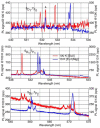Hysteretic Photochromic Switching (HPS) in Doubly Doped GaN(Mg):Eu-A Summary of Recent Results
- PMID: 30248983
- PMCID: PMC6213339
- DOI: 10.3390/ma11101800
Hysteretic Photochromic Switching (HPS) in Doubly Doped GaN(Mg):Eu-A Summary of Recent Results
Abstract
Europium is the most-studied and least-well-understood rare earth ion (REI) dopant in GaN. While attempting to increase the efficiency of red GaN light-emitting diodes (LEDs) by implanting Eu⁺ into p-type GaN templates, the Strathclyde University group, in collaboration with IST Lisbon and Unipress Warsaw, discovered hysteretic photochromic switching (HPS) in the photoluminescence spectrum of doubly doped GaN(Mg):Eu. Our recent work, summarised in this contribution, has used time-, temperature- and light-induced changes in the Eu intra-4f shell emission spectrum to deduce the microscopic nature of the Mg-Eu defects that form in this material. As well as shedding light on the Mg acceptor in GaN, we propose a possible role for these emission centres in quantum information and computing.
Keywords: europium; gallium nitride; photochromism; photoluminescence; qubit; rare earth ions.
Conflict of interest statement
The authors declare no conflict of interest. The funders had no role in the design of the study; in the collection, analyses, or interpretation of data; in the writing of the manuscript, and in the decision to publish the results.
Figures









References
-
- O’Donnell K.P., Dierolf V., editors. Topics in Applied Physics 124. Springer; Dordrecht, The Netherlands: 2010. Rare-Earth Doped III-Nitrides for Optoelectronic and Spintronic Applications.
-
- O’Donnell K.P. 2012 UKNC Winter Meeting. University of Bath; Bath, UK: 2012. Unpublished talk.
-
- Lany S., Zunger A. Dual nature of acceptors in GaN and ZnO: The curious case of the shallow MgGa deep state. Appl. Phys. Lett. 2010;96:142114. doi: 10.1063/1.3383236. - DOI
Publication types
Grants and funding
LinkOut - more resources
Full Text Sources
Other Literature Sources
Research Materials

